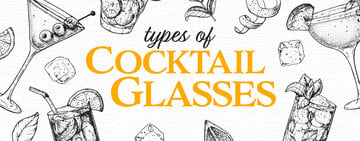What Is the Difference Between Glass and Crystal?
Last updated on May 12, 2025Janine JonesWhen preparing a full course meal for a catered event or elevating the ambiance of a romantic Valentine's dinner special, you might consider setting the tables with your finest crystal glassware. Crystal glass has a reputation for being a luxurious choice for upscale dining establishments, but what sets it apart from standard glassware? We explore the distinctions between crystal and glass so you can create an elegant table setting for your upcoming event.
Shop All Crystal Wine GlassesCrystal vs Glass

When comparing glass vs crystal, crystal is a type of glass that contains strengthening minerals like lead oxide, potassium carbonate, and silica to make the material durable. The added strength allows the crystal to be molded into thin, delicate shapes. Standard glass is usually made with sand, soda ash, and limestone, making it durable but unable to be molded as thin as crystal. Crystal refracts light better than glass, making crystal more sought out for formal table settings and more expensive than glass.
What Is Glass?
Glass is a transparent material that can be melted down and molded into solid shapes. It is made from sand, soda ash, and limestone, but other minerals like silica and barium can be added to manipulate its color, durability, and thickness.
Glass with a low mineral count is non-porous, which makes glass dishwasher-safe and heat-resistant. Some popular types of glass used in public settings are borosilicate glass, commonly used for glass food storage containers, and fused quartz glass used for camera lenses and lab equipment.
What Is Crystal?
Crystal glass is a transparent material made with the same ingredients as glass but with added lead oxide or metal oxide. Thanks to these additional ingredients, crystal retains its integrity even when cut or blown. Crystal glasses' material is slightly porous so it refracts light brilliantly. However, this also means some forms of crystal are not dishwasher safe. Always check the manufacturer's instructions for how to clean and polish glassware.
Crystal is produced by companies around the globe and can be made with varying levels of lead oxide. Despite what its name suggests, crystal glass does not contain a crystalline structure in its material compound. The name is derived from the Italian term “Cristallo”, which was used for high-end hand-blown glass in Murano, Italy. Its association with sophistication makes crystal desirable and higher in price than glass.
The Differences Between Glass and Crystal

Glass and crystal are both heated in a furnace until molten, blown by a glassblower, and then shaped into the desired designs. However, the two materials feature differences. From their chemical composition and weight to how they refract light and reverberate sound, crystal and glass products offer different user experiences. We compare their differences below to clarify why crystal tableware is more expensive.
Appearance Differences
- Glass: Glass is often slightly foggy in appearance and can typically feature a tint based on the ingredients in its composition. It can have a green tint if made with iron or a blue tint if made with soda-lime.
- Crystal: Crystal boasts incredible clarity, which makes it a desirable choice for high-end types of glassware and decorations.
Weight Differences
- Glass: Glass products are lighter than crystal pieces of the same design.
- Crystal: Because crystal contains lead or other metals, it tends to be heavier than standard glass of the same design.
Thickness Differences
- Glass: Due to the soda-lime in its chemical composition, glass requires a high working temperature and hardens rather quickly after being heated, which results in a thick rim. The material is more fragile than crystal so most cup rims will be reinforced for added strength.
- Crystal: Crystal can be heated at lower temperatures than glass because of the lead and potassium carbonate in the composition. This allows the glassblower to work the material into a thin yet sturdy design. The additional chemicals also help the material remain strong when stretched further than glass.
Cut Differences

- Glass: Since glass hardens more quickly than crystal, it offers little time to be cut by hand. The material is generally too hot to manage with gloves so glass is typically bent into shape while hot or blown into a mold. Any cuts on the surface are usually sharp, rigid, and brittle.
- Crystal: Since crystal is strengthened by its minerals, it is soft enough to add smooth hand-cut details to its surface without compromising its durability. The material is more malleable than glass, allowing the artist to add intricate patterns. The cuts can then be buffed and polished without fear of shattering the structure.
Refraction Differences
- Glass: Glass typically has a refractive index of 1.46 or lower.
- Crystal: Crystal typically has a refractive index of 1.52 or higher.
Sound Differences
- Glass: Glass provides a dull chime when tapped or flicked. The sound is usually short in length and subtle.
- Crystal: When tapped, crystal creates a satisfying bell-like ringing sound. The lead content in the material allows the sounds to be slightly prolonged.
Benefits of Glass vs Crystal
- Glass: Glass tableware is a great option for everyday use because it is thick and durable. It can be put in the dishwasher for easy cleanup and has a reinforced rim to prevent chips and cracks.
- Crystal: Crystal glass refracts light beautifully, glinting light into rainbows. This makes it an excellent choice for cups, bowls, vases, champagne flutes, chandeliers, and ornaments. It can also be molded thin, which means that wine glasses can have a thin rim, providing an uninterrupted flow of wine. Crystal is also popular at weddings because of the ringing noise it makes when glasses are clinked.

Crystal FAQs

Although crystal has been used since the 17th century, people still speculate about its safety and crafting. We answer some of the most frequently asked questions about crystal below.
What Is Lead Crystal and Is It Safe?
Lead crystal is glass that uses lead oxide as a strengthening and clarification agent. Lead crystal is not considered safe for beverage or food storage. If you are using lead crystal for a single beverage or food serving, then there is a low risk of lead consumption. However, if you store a liquid in lead crystal for a prolonged time, such as storing whiskey in a decanter, you may risk lead leaching into your beverage.
According to the European Union, crystal must contain at least 24% lead oxide to merit the title of lead crystal. Anything below that rating must be strictly labeled as crystal glass or crystalline. In the United States, any glass with 1% lead oxide can carry a crystal label.
Does All Crystal Have Lead?
Not all crystal glass contains lead. You can find lead-free crystal glass that uses alternative metal oxides, such as barium oxide, potassium oxide, zinc oxide, and magnesium, instead of lead oxide. This is to make the glass safe for food storage removing concerns of lead leaching into the food or beverage. The best way to know if your crystal contains any lead is to have it lab-tested.
Whether you’re catering a wedding or serving festive holiday cocktails at a Christmas party, crystal can help you bring your event to a higher level of sophistication. Make a great impression on your guests with eye-catching glassware.



